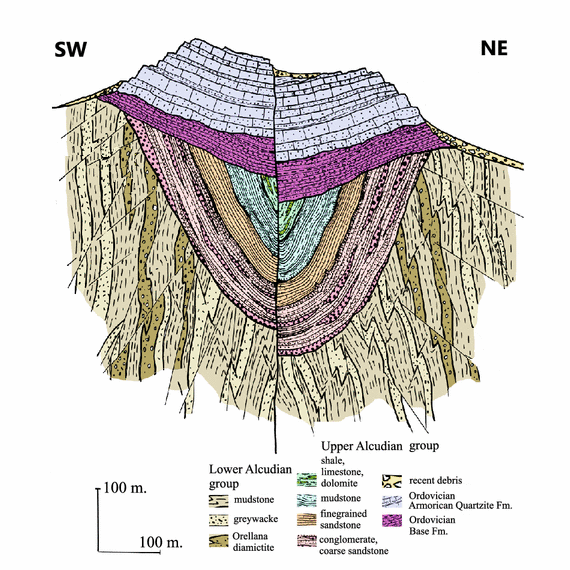Today’s Friday fold is the last question on the Historical Geology midterm exam I gave today.

This is a diagram showing a cross-section through the rocks at Villuercas-Ibores-Jara UNESCO Global Geopark in Extremadura, Spain. It comes from a field guide to the region by J.J. Álvaro, S. Jensen, and T. Palacios. I stumbled across the image while searching for something else, and was immediately struck by its elegance and graphical balance, but also how it showed a deep time story with many discernible chapters. I modified their image to trim it down to what I considered to be the essential components for my own students, but I was so pleased with the story that popped out that I also posted it on Twitter today, challenging geo-students there to take a crack at deciphering the saga from the information in this cross-section. Despite likes and retweets, no one was brave enough to put forward some observations and interpretations.
Can you?
Before you scroll any further down this blog post (and see my answer), see what sense you can tease out of this accumulation of lines, wiggles, and dots….
(keep scrolling…)
(keep scrolling…)
Okay, here’s what I see:
- Once upon a time, there was a deep marine basin where most of the time, mud was deposited.
- Periodically, turbidites would bring in layers of graywacke.
- At some point, either a glacier dumped a bunch of debris in, or there were some submarine landslides that resulted in an exceptionally poorly sorted deposit of diamictite. (We can’t tell from the data available here whether the clasts in that diamictite are faceted and striated or not.)
- Then there was an episode of folding and faulting, probably accompanying an episode of mountain-building. Roughly speaking, and with the diamictite acting as our marker unit, the strata were warped into what appears to be a regional antiform in structure.
- This tectonic squeezing resulted in uplift, subjecting our now-near-vertical strata to a time of erosion. The mudstone, graywacke, and diamictite layers were truncated against the ancient Earth’s surface.
- Time went by and subsidence occurred, allowing sea level to creep back up and over the site. Higher-energy fluvial or shoreline (delta) deposits were laid down. Based on the lens-shaped deposits of conglomerate within the coarse sandstone, it looks like this was either terrestrial or transitional. The base of the unit makes an angular unconformity with the layers described in steps 1-5.
- On top of that is a layer of fine-grained sandstone, perhaps indicating beach or nearshore marine deposition.
- On top of that is a layer of mudstone, going back to a more offshore setting, and…
- Topping that is a layer of limestone, dolostone, and shale – the most offshore facies yet. In total, this package represents a classic fining-upward transgressive sequence.
- Then another episode of compression happened, folding all these layers into a big synform.
- Once again, this uplifted the edges of some of the layers to the surface, where they were eroded.
- Again, subsidence and/or sea level rise (during the Ordovician, according to the explanation) brought deposition back to the site, resulting in the “Base” Formation. An angular unconformity exists now between the base of the Base and the underlying high-angle strata.
- Based on truncation of some of the upper layers of the Base Formation against the overlying unit, I’m guessing there was another round of erosion.
- Deposition resumed anew, with layers of quartz sand, also during the Ordovician. This makes an unconformity with respect to the underlying Base layers.
- Then there was a little bit of folding (pretty subtle), again effecting all layers, but most noticeable in the non-horizontality of the Ordovician package.
- Then faulting down-dropped the northeast side relative to the southwest.
- Then (or perhaps accompanying #16) uplift brought it all above the surface, where erosion went to work again, breaking down the mountainous outcrop and laying down temporary (?) deposits of Recent debris.
Whew! What a tale. I can’t wait to someday see these rocks in person.
Happy Friday.

It is very interesting to read the strata history. Here in the Catskills the fluvial deltaic sedimentary deposits of sandstone shale and conglomerate-bluestone are a lot easier to read and extrapolate from. The age of the Catskill Delta rocks here average between 370-385 million years.
It seems you or someone else gave this test a few years ago..?